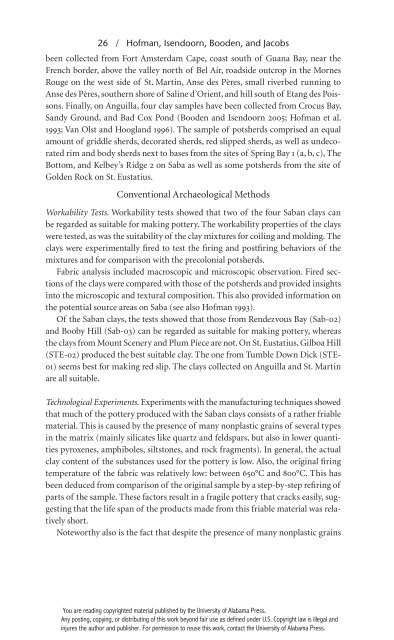Crossing the Borders: New Methods and Techniques in the Study of Archaeological Materials from the Caribbean
by Corrine L. Hoffman, et. al.
by Corrine L. Hoffman, et. al.
You also want an ePaper? Increase the reach of your titles
YUMPU automatically turns print PDFs into web optimized ePapers that Google loves.
26 / H<strong>of</strong>man, Isendoorn, Booden, <strong>and</strong> Jacobs<br />
been collected <strong>from</strong> Fort Amsterdam Cape, coast south <strong>of</strong> Guana Bay, near <strong>the</strong><br />
French border, above <strong>the</strong> valley north <strong>of</strong> Bel Air, roadside outcrop <strong>in</strong> <strong>the</strong> Mornes<br />
Rouge on <strong>the</strong> west side <strong>of</strong> St. Mart<strong>in</strong>, Anse des Pères, small riverbed runn<strong>in</strong>g to<br />
Anse des Pères, sou<strong>the</strong>rn shore <strong>of</strong> Sal<strong>in</strong>e d’Orient, <strong>and</strong> hill south <strong>of</strong> Etang des Poissons.<br />
F<strong>in</strong>ally, on Anguilla, four clay samples have been collected <strong>from</strong> Crocus Bay,<br />
S<strong>and</strong>y Ground, <strong>and</strong> Bad Cox Pond (Booden <strong>and</strong> Isendoorn 2005; H<strong>of</strong>man et al.<br />
1993; Van Olst <strong>and</strong> Hoogl<strong>and</strong> 1996). The sample <strong>of</strong> potsherds comprised an equal<br />
amount <strong>of</strong> griddle sherds, decorated sherds, red slipped sherds, as well as undecorated<br />
rim <strong>and</strong> body sherds next to bases <strong>from</strong> <strong>the</strong> sites <strong>of</strong> Spr<strong>in</strong>g Bay 1 (a, b, c), The<br />
Bottom, <strong>and</strong> Kelbey’s Ridge 2 on Saba as well as some potsherds <strong>from</strong> <strong>the</strong> site <strong>of</strong><br />
Golden Rock on St. Eustatius.<br />
Conventional <strong>Archaeological</strong> <strong>Methods</strong><br />
Workability Tests. Workability tests showed that two <strong>of</strong> <strong>the</strong> four Saban clays can<br />
be regarded as suitable for mak<strong>in</strong>g pottery. The workability properties <strong>of</strong> <strong>the</strong> clays<br />
were tested, as was <strong>the</strong> suitability <strong>of</strong> <strong>the</strong> clay mixtures for coil<strong>in</strong>g <strong>and</strong> mold<strong>in</strong>g. The<br />
clays were experimentally fired to test <strong>the</strong> fir<strong>in</strong>g <strong>and</strong> postfir<strong>in</strong>g behaviors <strong>of</strong> <strong>the</strong><br />
mixtures <strong>and</strong> for comparison with <strong>the</strong> precolonial potsherds.<br />
Fabric analysis <strong>in</strong>cluded macroscopic <strong>and</strong> microscopic observation. Fired sections<br />
<strong>of</strong> <strong>the</strong> clays were compared with those <strong>of</strong> <strong>the</strong> potsherds <strong>and</strong> provided <strong>in</strong>sights<br />
<strong>in</strong>to <strong>the</strong> microscopic <strong>and</strong> textural composition. This also provided <strong>in</strong>formation on<br />
<strong>the</strong> potential source areas on Saba (see also H<strong>of</strong>man 1993).<br />
Of <strong>the</strong> Saban clays, <strong>the</strong> tests showed that those <strong>from</strong> Rendezvous Bay (Sab-02)<br />
<strong>and</strong> Booby Hill (Sab-03) can be regarded as suitable for mak<strong>in</strong>g pottery, whereas<br />
<strong>the</strong> clays <strong>from</strong> Mount Scenery <strong>and</strong> Plum Piece are not. On St. Eustatius, Gilboa Hill<br />
(STE-02) produced <strong>the</strong> best suitable clay. The one <strong>from</strong> Tumble Down Dick (STE-<br />
01) seems best for mak<strong>in</strong>g red slip. The clays collected on Anguilla <strong>and</strong> St. Mart<strong>in</strong><br />
are all suitable.<br />
Technological Experiments. Experiments with <strong>the</strong> manufactur<strong>in</strong>g techniques showed<br />
that much <strong>of</strong> <strong>the</strong> pottery produced with <strong>the</strong> Saban clays consists <strong>of</strong> a ra<strong>the</strong>r friable<br />
material. This is caused by <strong>the</strong> presence <strong>of</strong> many nonplastic gra<strong>in</strong>s <strong>of</strong> several types<br />
<strong>in</strong> <strong>the</strong> matrix (ma<strong>in</strong>ly silicates like quartz <strong>and</strong> feldspars, but also <strong>in</strong> lower quantities<br />
pyroxenes, amphiboles, siltstones, <strong>and</strong> rock fragments). In general, <strong>the</strong> actual<br />
clay content <strong>of</strong> <strong>the</strong> substances used for <strong>the</strong> pottery is low. Also, <strong>the</strong> orig<strong>in</strong>al fir<strong>in</strong>g<br />
temperature <strong>of</strong> <strong>the</strong> fabric was relatively low: between 650°C <strong>and</strong> 800°C. This has<br />
been deduced <strong>from</strong> comparison <strong>of</strong> <strong>the</strong> orig<strong>in</strong>al sample by a step- by- step refir<strong>in</strong>g <strong>of</strong><br />
parts <strong>of</strong> <strong>the</strong> sample. These factors result <strong>in</strong> a fragile pottery that cracks easily, suggest<strong>in</strong>g<br />
that <strong>the</strong> life span <strong>of</strong> <strong>the</strong> products made <strong>from</strong> this friable material was relatively<br />
short.<br />
Noteworthy also is <strong>the</strong> fact that despite <strong>the</strong> presence <strong>of</strong> many nonplastic gra<strong>in</strong>s<br />
You are read<strong>in</strong>g copyrighted material published by <strong>the</strong> University <strong>of</strong> Alabama Press.<br />
Any post<strong>in</strong>g, copy<strong>in</strong>g, or distribut<strong>in</strong>g <strong>of</strong> this work beyond fair use as def<strong>in</strong>ed under U.S. Copyright law is illegal <strong>and</strong><br />
<strong>in</strong>jures <strong>the</strong> author <strong>and</strong> publisher. For permission to reuse this work, contact <strong>the</strong> University <strong>of</strong> Alabama Press.


















